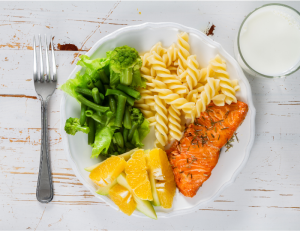Portion sizes have changed noticeably over the years. They have gotten bigger and so have humans. Extra portions may lead to extra weight. It is hard to set limits when you eat without boundaries. Many people don’t know what a healthy portion size is. The rule of thumb is to be wise about your portion size!
What is a portion size? A portion size is the amount of food or drink a person chooses to eat or drink at one time and/or one meal.
Extra calories and extra portions, lead to extra weight, when the calories taken in, are not burned during activities of daily living. Some sandwiches and hamburgers have gone from 3-ounce portions to 5-9 ounces and more. Drinks have become available in many sizes including supersized. Restaurants often serve large meals that are enough for two meals. It is easy to eat what is in front of you, without even thinking about it.
It’s very important to stay in control of portion size of the food and drinks you consume, for your health and wellbeing.

These are some examples of easy to remember portion size estimates:
- Your thumb is about the same size as 1 ounce of cheese.
- A small handful is equal to 1-2 ounces of nuts and 2 handfuls is 1 ounce of chips or pretzels.
- The palm of your hand, minus the fingers, is about 3 ounces of meat, fish, or chicken.
- A deck of cards is about the same size as 3 ounces of meat, fish, or chicken.
- Your fist is equal to 1 cup of cereal, fruit, or vegetables.
We have seen recently in the news that medications and surgery are being recommended for childhood obesity. It is a good reminder for us all that diet and exercise go hand in hand and can help control obesity. As part of a healthy lifestyle, we all need a general food or menu plan and an exercise plan or routine. What you put in your body needs to fuel your body to do the things we do. The excess calories need to be burned up or expended. Physical activity burns up calories. If you are putting too much fuel into your body and it isn’t burning it up, you will gain weight. If you are putting in just the right amount and you are at a healthy weight, you will maintain that body weight. If you are limiting and cutting back on excess calories, based on your individual caloric needs, and burning up the food you eat, you will lose weight. It is truly a balance. For your specific calorie needs, discuss this with your health care provider.
MyPlate can help you choose the amounts and types of foods you eat. Visit MyPlate.gov for more information. Calorie needs are different for different people based on gender, age, activity level, and height and weight. Be careful that your portions are not slowly creeping up in size over time.

Here are a few tips:
- Know what a recommended serving size is. See MyPlate.gov
- Read the nutrition facts label to tell you the intended serving size and calorie content.
- Use a smaller dinner plate or bowl.
- Use a smaller coffee cup or drinking glass.
- Use measuring cups and spoons to determine portion size.
- Use smaller serving utensils. You will take/serve less.
- Limit high calorie, large size sweetened coffee drinks and other supersized beverages.
- Limit stress eating and engage in other positive activities instead.
- You don’t have to eat all the food on your plate and/or all the food that was prepared for one meal. Save the extra, uneaten servings for another meal. Don’t eat them just because they are there. Don’t eat them when you are cleaning up either. Store them for another meal.
- Eat from a plate or bowl not straight from the box or bag. Example: Place one serving of pretzels or whole grain chips in a bowl and put the bag away and out of site.
- Limit the number of nuts you eat in one sitting as one portion. It’s a small handful not a can full.
- Consider eating a small banana or cutting a large one in half.
- Split a large meal with a family member or friend, when dining out or ask for a to-go container to take the leftovers home for another meal.
- Eat one slice of pizza instead of three. Eat the one slice with a nice mixed green salad.
- Don’t eat in front of the TV or any other screen. Eat at a table.
- Keep tempting high calorie foods out of sight and even better out of your home.
- Tell well-meaning friends and relatives to avoid giving you gifts of food, as you are trying to control your weight.
- Serve food on to individual plates. Don’t put the entire serving bowl or cooking pot on the table. Keep the extra food out of reach. This can be tempting to go back for second and third helpings.
Maintaining a healthy weight is a balancing act. Stay in control. Aim for a healthy weight. Follow your menu plan. Stick to your exercise routine. Monitor your portion size for better health.
Portion control matters. Portion size matters.
Resources to learn more:
MyPlate.gov Plan- https://www.myplate.gov/myplate-plan
Follow the rainbow for good health- https://blogs.ifas.ufl.edu/browardco/2022/03/01/follow-the-rainbow-for-good-health-during-nutrition-month/
5 reasons to exercise- https://blogs.ifas.ufl.edu/browardco/2022/06/22/five-reasons-to-start-exercising-today/
Diabetes Meal Planning- Diabetes Meal Planning | CDC
Focus on Fruits and Vegetables- https://blogs.ifas.ufl.edu/browardco/2022/07/01/get-health-benefits-this-summer-focus-on-fruits-and-vegetables/
Time to Focus on Self-care- https://blogs.ifas.ufl.edu/browardco/2021/07/26/time-to-focus-on-self-care/
The secret to serving size in your hand/Iowa WIC- svg_size_engligh.pdf (iowa.gov)
Keep an eye on portion size- https://www.nhlbi.nih.gov/health/educational/wecan/portion/keep.htm

An equal opportunity institution.
 11
11
